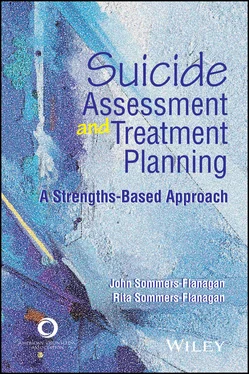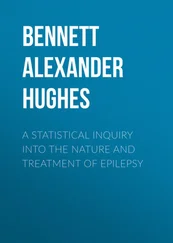John Sommers-Flanagan - Suicide Assessment and Treatment Planning
Здесь есть возможность читать онлайн «John Sommers-Flanagan - Suicide Assessment and Treatment Planning» — ознакомительный отрывок электронной книги совершенно бесплатно, а после прочтения отрывка купить полную версию. В некоторых случаях можно слушать аудио, скачать через торрент в формате fb2 и присутствует краткое содержание. Жанр: unrecognised, на английском языке. Описание произведения, (предисловие) а так же отзывы посетителей доступны на портале библиотеки ЛибКат.
- Название:Suicide Assessment and Treatment Planning
- Автор:
- Жанр:
- Год:неизвестен
- ISBN:нет данных
- Рейтинг книги:4 / 5. Голосов: 1
-
Избранное:Добавить в избранное
- Отзывы:
-
Ваша оценка:
- 80
- 1
- 2
- 3
- 4
- 5
Suicide Assessment and Treatment Planning: краткое содержание, описание и аннотация
Предлагаем к чтению аннотацию, описание, краткое содержание или предисловие (зависит от того, что написал сам автор книги «Suicide Assessment and Treatment Planning»). Если вы не нашли необходимую информацию о книге — напишите в комментариях, мы постараемся отыскать её.
Suicide Assessment and Treatment Planning — читать онлайн ознакомительный отрывок
Ниже представлен текст книги, разбитый по страницам. Система сохранения места последней прочитанной страницы, позволяет с удобством читать онлайн бесплатно книгу «Suicide Assessment and Treatment Planning», без необходимости каждый раз заново искать на чём Вы остановились. Поставьте закладку, и сможете в любой момент перейти на страницу, на которой закончили чтение.
Интервал:
Закладка:
Knowledge acquisition. Foundational knowledge includes information on effective assessment and treatment and an understanding of ethical and legal standards. Having greater foundational knowledge of suicide helps increase your confidence and frees you to experience and express compassion for clients struggling with suicidality.
Skill development. This refers to learning and practicing specific skills and strategies, including (a) comfortably asking about suicide; (b) empathically interacting with clients who are experiencing depression, hopelessness, and irritability; (c) engaging in collaborative assessment; (d) developing collaborative treatment and safety plans; (e) implementing specific interventions; and (f) documenting clinical decision-making.
At the beginning and throughout the symphony of suicide-related self-awareness, knowledge, and skill acquisition, there is a steady drumbeat of ethical and legal standards in the background. This drumbeat will sometimes distract you; other times it will provoke anxiety. On good days, local and national practice standards will guide your work with clients who are suicidal. Practice standards include knowledge of ethical decision-making models, breaching confidentiality, documentation, and much more.
Within the counselor education discipline, there is little guidance or consensus regarding suicide assessment and treatment competence. The 2016 Council for Accreditation of Counseling and Related Educational Programs (CACREP) Standards (CACREP, 2016) include two statements pertaining to required counseling coursework in “Suicide prevention models and strategies” (Section 2.F.5.l.) and “Procedures for assessing risk of aggression or danger to others, self-inflicted harm, or suicide” (Section 2.F.7.c.). Similarly, the ACA Code of Ethics (American Counseling Association [ACA], 2014) mentions suicide once, but only in the context of the storage and disposal of records. Standard C.2.b. of the Code offers general guidance for “New Specialty Areas of Practice.” It reads: “Counselors practice in specialty areas new to them only after appropriate education, training, and supervised experience . . . counselors take steps to ensure the competence of their work and protect others from possible harm.” Although working with suicidality is not an identified practice specialty, counselors need specialized education, training, and supervised experience in suicide assessment and treatment.
Similar to counselor education, other professional disciplines also offer little guidance regarding suicide-related competence. The American Psychological Association (2010) does not use the words suicide or suicidal in its accreditation standards or ethics code, but it does have a helpful informational and resource-oriented website (see https://www.apa.org/topics/suicide/). Although the American Academy of Child and Adolescent Psychiatry has a practice parameter for the assessment and treatment of children and adolescents with suicidal behavior, its guidance has not been revised since 2001. Similar to ACA and the American Psychological Association, the National Association of Social Workers (2017) provides links to documents about suicide prevention and treatment but offers no formal training guidelines.
Recently, the American School Counselor Association took a step forward in this area, publishing a “Suicide Risk Assessment Position Statement” (Sara Carpenter, personal communication, July 3, 2020). This statement clarifies the role of school counselors as part of a collaborative care team that uses evidence-supported strategies and always reports students’ elevated suicide risk to parents, guardians, or, in cases of caregiver abuse or neglect, child protective services (American School Counselor Association, 2020).
In contrast to the sparse mention of specific training protocols linked to professional organizations, the scientific literature on suicide assessment, treatment planning, and interventions is immense. At the time of this writing, we found more than 32,000 publications on PsycINFO with suicide or suicidal in the title. Keeping up with the professional literature on suicide could be a full-time job.
Fortunately, suicide researchers and professional organizations frequently summarize the literature. Several researchers and organizations have described essential suicide assessment and treatment competencies. Most prominently, the American Association of Suicidology (AAS; 2010), a national organization dedicated to studying suicide, identified 24 competencies organized under eight broad categories. Several additional competency guidelines and models exist. To simplify the smorgasbord of competencies available, Cramer and colleagues (2013) distilled principles from five different competency guides (including AAS) into 10 core competencies. Even simplified, the 10 core competencies constitute a wide array of attitudes, knowledge, skills, and practice standards. In this chapter, we provide an initial overview; throughout the rest of this book we offer case vignettes, extended case examples, and commentary relevant to the 10 core competencies.
Ten Suicide Assessment and Treatment Planning Competencies
Cramer and colleagues (2013) reviewed suicide competencies from several published documents, including AAS (2010), Joiner (2005), Kleespies et al. (2009), Rudd (2006), and Sullivan and Bongar (2009). Based on their review, they identified 10 suicide assessment and treatment planning competencies. Although they drew primarily from psychology, psychiatry, and the interdisciplinary AAS, Cramer et al.’s competencies are consistent with content from the counseling discipline (Granello, 2010a, 2010b). For each suicide competency, we provide a descriptive summary and commentary illuminating particular challenges that professionals face when mastering these competencies.
Competency 1: Be Aware of and Manage Your Attitude and Reactions to Suicide
Competency begins with self-awareness. Nearly every source on suicide prevention and intervention emphasizes self-reflection designed to answer the question “Can I work effectively and ethically with clients who are suicidal?” (J. Sommers-Flanagan & Sommers-Flanagan, 2017). Granello (2010b) recommended that professionals manage and balance their emotional reactions:
Counselors may overreact to any mention of suicide and impose overly restrictive controls. The opposite risk, which can be much more serious, occurs when counselors deny the level of threat and underreact by not imposing sufficient controls. Either situation, when arising from the emotional reactions of the counselor rather than the needs of the client, is dangerous. (p. 222)
Everyone has preexisting attitudes toward suicide. Some individuals hold the belief that suicide is sinful; others believe in the individual’s right to die by suicide. As a mental health or school professional, it is important for you to be aware of your preexisting attitudes and to be prepared for ways in which suicidality in clients might affect you. This includes being aware of your religious beliefs, your personal history with suicide, and any ways that you are inclined to instantly judge people who mention the word suicide .
Competency 2: Develop and Maintain a Collaborative, Empathic Stance With Clients
When clients disclose suicidality, conflicts between clinician goals and client goals arise (AAS, 2010). Clients who present with suicidal ideation or impulses are often expressing a desire to die; in contrast, your professional goal is to help clients stay alive. This inherent conflict makes it difficult to establish collaborative relationships (Jobes, 2016).
Clients know their pain and the nature of their suffering. If clinicians do not honor client perspectives, clients can refuse to open up; they can slide the deadbolt to their inner thoughts and feelings and block clinicians from gathering information. A collaborative attitude requires respecting client perspectives. That often means honoring your clients’ desire to keep suicide as an option to life. Pushing against clients’ rights to die by suicide may activate psychological reactance or resistance and end up pushing them toward, rather than away from, suicide (Brehm & Brehm, 1981; J. Sommers-Flanagan & Shaw, 2017). A collaborative relationship is central to all contemporary and evidence-based approaches to suicide assessment and management (Bryan & Rudd, 2018; Jobes, 2016; Wenzel et al., 2009).
Читать дальшеИнтервал:
Закладка:
Похожие книги на «Suicide Assessment and Treatment Planning»
Представляем Вашему вниманию похожие книги на «Suicide Assessment and Treatment Planning» списком для выбора. Мы отобрали схожую по названию и смыслу литературу в надежде предоставить читателям больше вариантов отыскать новые, интересные, ещё непрочитанные произведения.
Обсуждение, отзывы о книге «Suicide Assessment and Treatment Planning» и просто собственные мнения читателей. Оставьте ваши комментарии, напишите, что Вы думаете о произведении, его смысле или главных героях. Укажите что конкретно понравилось, а что нет, и почему Вы так считаете.











